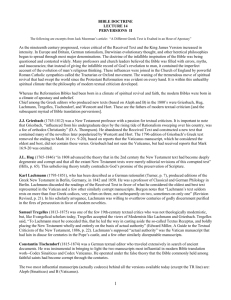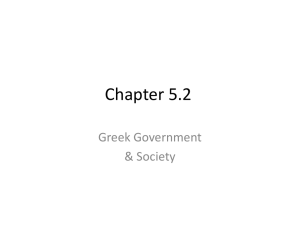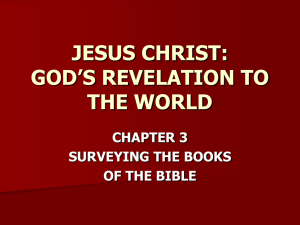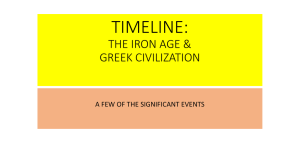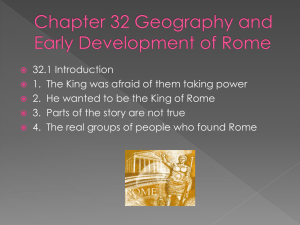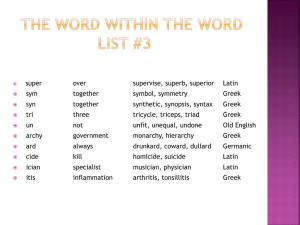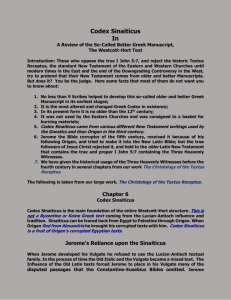Lesson5
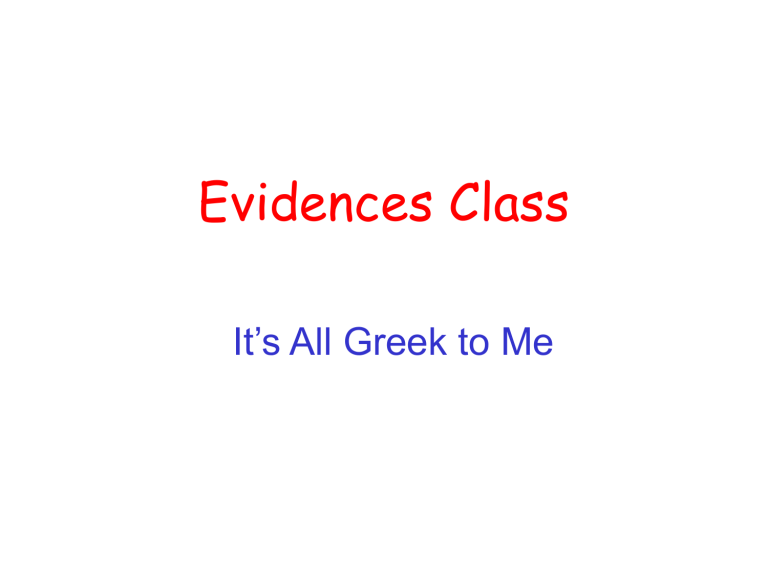
Evidences Class
It’s All Greek to Me
Although some early Greek city states had democracies, a powerful monarchy gained dominance in the 4 th century
B.C. Under their greatest king
Alexander III, the Greeks conquered most of the Middle
East. Greek influence and the Greek language spread with it.
Alexander the Great
Alexander the Great died mysteriously at the age of 32, but his conquests changed the culture and language of the Mediterranean region. This
Greek influence is called Hellenism. You can see the Hellenist influence today as far away as
Jerash in modern day Jordan.
Jerash
The Parthenon
Just Consider
When a city is conquered by an invading nation, in time that city will begin to take on the culture and language of the invader.
In this way, Greek became the principal language of commerce, government, and education. Many Jews became Hellenized and lost their knowledge of Hebrew.
What does Septuagint Mean?
Even before the Dead Sea Scrolls were found, there were examples of the Hebrew
Bible in Greek. Beginning in 300 B.C.,
Hellenized Jews began translating the
Hebrew scriptures into Greek. This earliest
Greek version of Hebrew scripture is called the Septuagint (LXX).
Legend of a Name
The name derives from a legend that 72 (70?) scholars from all 12 tribes of Israel translated the first 5 books (The Pentateuch) in
72 days. However, the northern tribes were dispersed by the
Assyrians in 722 B.C. and only three tribes were likely present and accounted for in the 3 rd
Century. Most scholars believe
Greek speaking Jews in Alexandria,
Egypt performed this translation between the 3 rd and 1 st centuries
B.C.
According to the Legend
Aristeas claims that the Septuagint was completed on the island of Pharos under the shadow of the lighthouse.
Is it a good translation?
• The Pentateuch is excellent
• Septuagint appears to be the correct reading rather than the oldest Hebrew manuscripts in a few cases
• Substantial variations in Joshua, 1
Samuel, 1 Kings, Proverbs, Esther, and
Jeremiah
• Which Septuagint?
• The translation that the Gospel writers and Paul quoted from
Replica of a Synagogue in Nazareth
Which OT Source did Jesus Quote?
And he came to Nazareth, where he had been brought up.
And as was his custom, he went to the synagogue on the
Sabbath day, and he stood up to read. And the scroll of the prophet Isaiah was given to him. He unrolled the scroll and found the place where it was written, "The Spirit of the Lord is upon me, because he has anointed me to proclaim good news to the poor. He has sent me to proclaim liberty to the captives and recovering of sight to the blind, to set at liberty those who are oppressed, to proclaim the year of the Lord's favor." And he rolled up the scroll and gave it back to the attendant and sat down. And the eyes of all in the synagogue were fixed on him.
(Luke 4:16-20 ESV)
Over time the Old Testament writings
(Hebrew scriptures and the Septuagint) became collectively known as the Old
Covenant, and the 1 st Century writings were called the New Covenant. The Latin word Testamentum meaning “covenant” came to be used in the West.
New Testament Writings
Polycarp (69-155 AD) included direct and indirect quotations from 19 of 27 New Testament books in a single letter.
Ignatius (35-107 AD) cited both the Gospel of John and the writings of Paul.
Papyrus
With constant use a papyrus manuscript might last only 10 years
Christians and Their Writings Suffer
Emperor Diocletian (245-305 AD) ordered Christians to sacrifice to the
Roman gods. Christian documents throughout the empire were confiscated and/or burned. Those who refused to comply were executed.
Manuscript
In general, anything written by hand
Documents written in the original tongue
NT manuscript is any Greek NT manuscript
Almost all surviving early writings are from Egypt
Diocletian’s Success
Only a few fragments of NT scripture exist from before the 4 th Century and all known fragments are Egyptian in Origin.
But Even So …
Author
Homer
Herodotus
Book
Iliad
History
Thucydides History
Plato
Caesar
Tacitus
Gallic Wars
Annals
Date Written
800 B.C.
480-425 B.C.
460-400 B.C.
400 B.C.
100-44 B.C.
A.D. 100
Earliest Copies c. 400 B.C.
c. A.D. 900 c. A.D. 900 c. A.D. 900 c. A.D. 900 c. A.D. 1100
Time Gap c. 400 years c. 1350 years c. 1300 years c. 1300 years c. 1000 years c. 1000 years
No. of Copies
643
8
8
7
10
20
Book
New Testament
Date Written
A.D. 50-100
Earliest Copies c. 114 (fragment) c. 200 (books) c. 250 (most of NT)
Time Gap
50+ years
100 years
150 years c. 325 (Complete NT) 225 years
No. of Copies
5366
Church Father Quotations …
Writer
Justin Martyr
Irenaeus
Clement (Alex.)
Origen
Tertullian
Hippolytus
Eusebius
Grand Totals
Gospels
268
1038
1107
9231
3822
734
3258
19368
Acts
10
194
44
349
502
42
211
1352
Pauline Epistles General Epistles Revelation
43
499
1127
7778
2609
387
1592
14035
6
23
207
399
120
27
88
870
3
65
11
165
205
188
27
664
The quotations are so extensive that the New Testament could be virtually reconstructed from them without the
New Testament Manuscripts.
Totals
330
1819
2406
17,992
7258
1378
5176
36,289
Oldest New Testament Fragment
John Rylands Papyrus
1 st half of the 2 nd century
Pilate said to them, "Take him yourselves and judge him by your own law." The Jews said to him, "It is not lawful for us to put anyone to death." This was to fulfill the word that Jesus had spoken to show by what kind of death he was going to die. So Pilate entered his headquarters again and called
Jesus and said to him, "Are you the
King of the Jews?"
(John 18:31-33 ESV)
Bodmer Papyrus (3 rd Century)
Contains parts of the Gospel of John
Similar to our oldest two
Bibles the Codex Vaticanus and Codex Sinaiticus
Uncials
Codex Vaticanus
Uncial Romans 1
PAULASERVANTOFCHRISTJESUSCALLED
TOBEANAPOSTLESETAPARTFORTHEGOS
PELOFGODWHICHHEPROMISEDBEFORE
HANDTHROUGHHISPROPHETSINTHEHO
LYSCRIPTURESCONCERNINGHISSON
Minuscules
Our Oldest Bibles (AD 300-450)
Codex Vaticanus Codex Sinaiticus
Codex Vaticanus
Located in the Vatican Library
Resided there since at least 1481
The spoils of war for Napolean
Tischendorf published a 1 st edition in 1867
Typical Small Differences
John 3:13 (ESV) No one has ascended into heaven except he who descended from heaven, the Son of
Man (who is in heaven).
John 8:57 (ESV) So the Jews said to him, “You are not yet fifty years old, and have you seen Abraham?” (has
Abraham seen you)
John 9:35 (ESV) Jesus heard that they had cast him out, and having found him he said, “Do you believe in the Son of Man?” (Son of God)
Mark 16:9-20
Most early Uncials include
Latin Vulgate
Irenaeus mentions in the 2 nd
Century
Curious space in the Codex
Vaticanus
Codex
Vaticanus
Saint Catherine’s
Monastery
Saint Catherine’s Monastery
Saint Catherine’s Monastery
Constantin Tischendorf
Of all Tischendorf’s accomplishments, the best known is his discovery of Codex Sinaiticus at
St. Catherine’s Monastery (located near Mount
Sinai). The manuscript, dated around AD 360 to 375, is one of the two oldest vellum (treated animal hide) manuscripts of the Greek New
Testament. The first time Tischendorf visited the monastery (1844), he retrieved several leaves of an ancient Septuagint from a wastebasket. Many other leaves, he was told, had already been used to stoke fires!
Constantin Tischendorf
On another visit (1859) he was shown a copy of the Greek Scriptures (containing books of the Old Testament and all of the
New Testament) by the steward of the monastery. Recognizing it as the oldest extant copy of the Greek Scriptures,
Tischendorf attempted to purchase the manuscript but was refused.
Constantin Tischendorf
After making a transcription of the text, Tischendorf did some political maneuvering wherein the czar of Russia was given the manuscript in exchange for favors conferred upon the authorities of the monastery.
Tischendorf greatly used the textual evidence of Codex Sinaiticus in preparing his critical editions of the
Greek New Testament.
